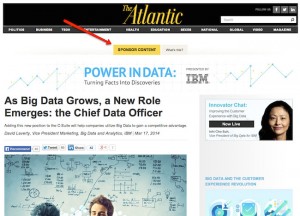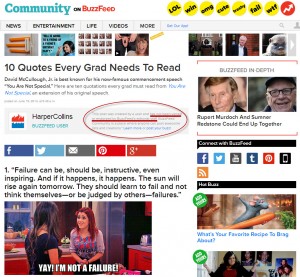By DANIELLE COOKSON
Upon looking at The Atlantic’s website (see picture left), you come across an article about a new role, the Chief Data Officer, for big data workers. Maybe you are interested in this position and are dying to learn more. But once you get to the last few paragraphs of the piece, you start to notice this “article” is promoting IBM and requesting that you check out their website for further info. Now, you scroll back up to the top of the page and see sponsored content outlined in a yellow box… Much to your confusion, you have been swindled into reading a page-long ad, NOT a feature article.
This sneaky advertisement trick is better known as an advertorial, or native ad—which is the act of passing off advertisements as editorial content. These advertorials, or native ads, are also known as such because this form of online advertising coincides with the form and function of the website it appears on. Stackadapt.com explains that the word “native” refers to the content’s coherence with other media on the platform.
While the use of online advertorials seem to get more attention, some readers don’t enjoy being sucked into reading a sponsored post. The issue with the credibility of these advertorials is the way they are written and seen by the audience; they come off as feature articles, when in reality they are just advertisements. Online advertorials blur the lines between advertising and journalism.
Legendary copywriter and “hypnotic advertiser” Joe Vitale of Mr.Fire.com made an observation that readers are up to 500 times more likely to read an advertorial than a straight ad: By considering an advertorial style, it can get 80 percent more attention than any other ad layout.
Not only does the advertisement appear as if it has come from an editor, it also gives the reader detailed information on a product or subject they may be interested in, considering it an objective source.
The advertorial Amanda Siciliano read dealt with why the “male model” doesn’t work for women inmates. It provided stats and facts about the women inmate population and talked about why learning about them is intriguing. Siciliano has said although she had been tricked by an advertorial, she realized how much it grabbed her attention and in the end, it persuaded her to watch a certain Netflix show.
“I remember I thought I was reading an article for the hit Netflix show, Orange is the New Black. The page detailed every characters personality and hobbies with awesome pictures and writing. It wasn’t until I was about to exit out of the site that I saw it was a sponsored content…after I read that ad, I started watching the show and I love it,”said Siciliano.
Although native ads produce more eyes than most advertisements, the Columbia Journalism Review’s Dean Starkman has made a point that these native ads have an existential problem and points out that not every online browser is a fan of the advertorial.
“So if we accept that advertising itself is a necessary evil, the only question for native ads is whether they’re clearly presented as advertisements and not editorial. That presents an existential problem for native ads: Make them too native and they deceive readers. Make them too non-native and few will read them,”said Starkman.
The story-telling website Contently conducted a study of over 500 U.S. internet users in which they found that two-thirds of readers have felt deceived upon realizing that an article or video was sponsored by a brand, 54 percent of readers don’t trust sponsored content, 59 percent of readers believe a news site loses credibility if it runs articles sponsored by a brand.
Ramapo senior Andrea Nathan said it is hard for her to further trust a site if she’s been tricked into reading an ad.
“I remember reading a Buzzfeed article with quotes and pictures about life after graduation. As I was reading at first, I noticed all of the writing was in quotes and wasn’t sure why. It wasn’t until I read the byline at the top of the page that I realized it was a sponsored post for a new book,” said Nathan.
“Buzzfeed is one of my favorite sites and I was pretty mad that I had read an ad rather than one of their unique posts…now I am sure to look for the sponsored content label at the top before I read anything,” said Nathan.
RELATED LINKS:



This was really informative. I never realized that advertorials were on many websites. The quotes you provided really helped the reader understand what an advertorial was as well. I also like how you posted related links, as well as the actual photo that Andrea Nathan saw on BuzzFeed.
I really liked your column, it made total sense as to why as I’m reading an article, I’ll stop and read an article that is posted on the side. I will click it and end up on some random page, but you never know what your getting yourself into. Also the pictures were an excellent source of outside information that really made readers understand the point of the article. Good touches